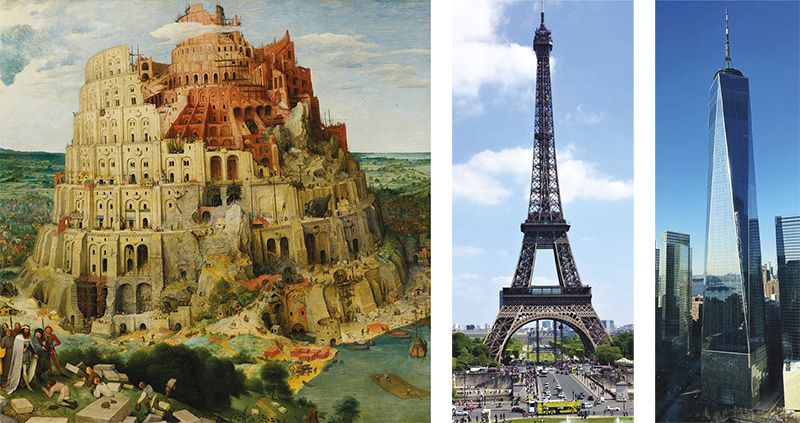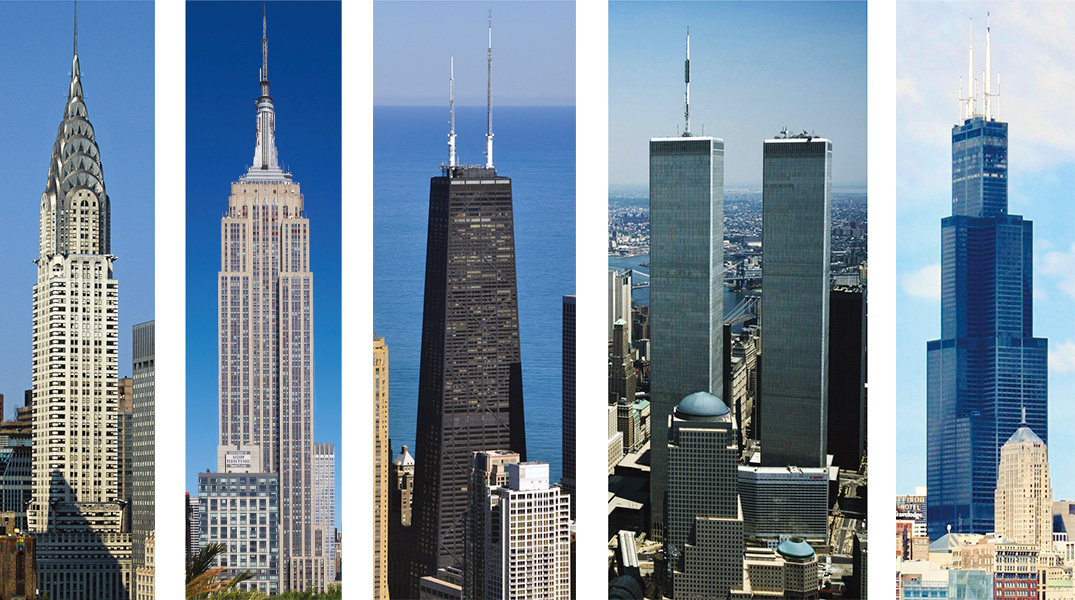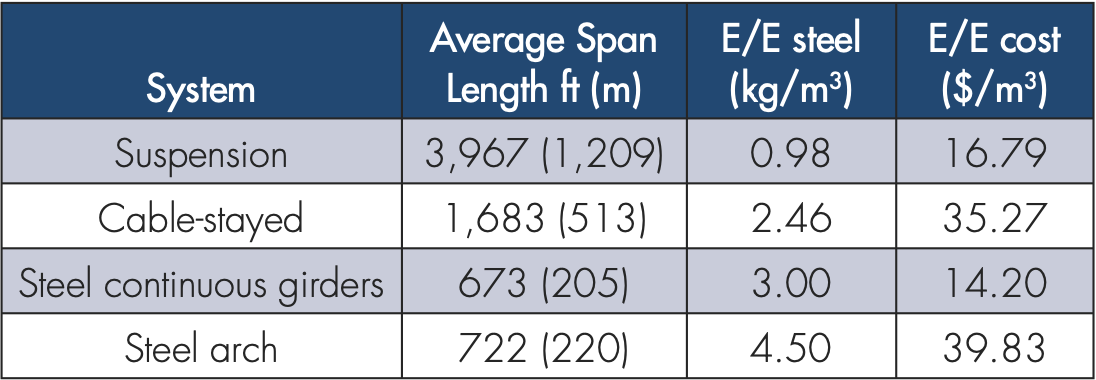Extreme structure development and the future.
Since ancient times, building greater, stronger, and faster has been part of humanity’s aspiration for greater achievement. The desire to surpass prior achievement is strongly embedded in the human mind and essential for development and progress. Since their projects can be easily compared, measured, and assessed for efficiency, engineers and builders have historically been on the frontline of this effort.
Exceptionally tall buildings and long-span bridges have a powerful impact and often become landmarks and symbols of a society’s financial, technological, and sociopolitical prowess. Earliest in this respect was the ziggurat temples of ancient Mesopotamia, most famously that at Babylon (the historical prototype of the Tower of Babel in the Bible), of which Nebuchadnezzar II (605–562 BC) boasted to have “raised its top to heaven” while just 107 ft (60m) tall. Not surprising as the first modern “skyscrapers” in 1884–1888 were not taller than 131–164 ft (40–50m). Similarly, Egyptian pharaohs strove to dazzle with the height and size of their pyramid tombs, most famously those at Giza. However, Khufu’s tomb (shortly after 2600 BC), whose original height was 481 feet (146.6m), remained the tallest building until the fourteenth century.

The Lighthouse of Alexandria, a building with multiple floors with fire on top, was built by Sostratos of Knidos (282–246 BC) at the entrance of Alexandria’s harbor. It stood probably some 328 feet (100m) tall. Damaged by earthquakes, the structure collapsed completely in the 14th century.
Medieval European cities likewise competed with the size and height of their cathedrals. The Lincoln in England exceeded the height of Khufu’s pyramid with its spire completion in 1311, reaching 525 feet (161.5 m). In modern times, the Eiffel Tower, erected in Paris in 1889, became the tallest man-made structure (until 1930) at 986 feet (300.5m), later increased to 1,083 feet (330m) with an antenna. This was the first monument built not for a higher power but to demonstrate technical advancement and ability. It also became a symbol of its city, country, and humankind’s everlasting strive toward new heights and achievements.
Modern skyscrapers originated in Chicago and New York City in the 1880s, with the Home Insurance Building in Chicago (1885), ten stories rising 138 feet (42.1m), later amplified to twelve stories (1891) and 180 feet (54.9m). The total height and number of stories became the subject of fierce competition in erecting these buildings. An example would be the Chrysler Building in New York City (1930), 1046 feet (318.8m), designed to exceed the height of both a skyscraper completed just before it and of the Eiffel Tower. Walter Chrysler specifically directed his architect, William Van Allen, to “build it taller than the Eiffel Tower!” However, as soon as the next year, the record for the tallest building passed to the Empire State Building (1931), with 1250 feet (381m), which was also the fastest-built skyscraper. The United States continued to lead in tallest buildings with the famous Chrysler Building, Empire State Building, New York City; World Trade Center, New York City, 1973, and Sears (now Willis) Tower, Chicago, 1973, until the completion of Petronas Towers in Kuala Lumpur in 1998.

The construction industry keeps track of and ranks accomplishments in the tallest buildings and structures, largest covered arenas, and longest bridge spans. Each new structural record has outcompeted prior top achievements in some respect, calling for exceptional designers and builders, innovative ideas and technology, efficient structural systems, stronger materials, excellent organization, and persistent efforts. This renders the competition for improvement essential for structural progress.
The inspiration to build greater, stronger, and faster is admirable, but is there a limit, or should there be one? Engineers can build a 9,800 feet (3,000m)-span bridge, but would the same be advisable for a 6,600 feet (2,000m)-tall tower or a 3,300 (1,000m)-wide building? No doubt they can achieve such extreme tasks, but are they really needed and functionally justified? Will they be useful and efficient once built?
Engineers and builders continue building taller and larger as such demands arise; however, in many cases, these needs have already been satisfied, if not surpassed. There is no genuine or pressing need for more skyscrapers taller than 2,500 feet (800m). A 3,300 feet (1,000m)-tall building cannot be more efficient to build and maintain than two 1,600 feet (500m) ones with equal floor area. Perhaps, by the 2020s, the era of super skyscrapers may be over. Satellites circling the earth provide better service than excessively tall TV and radio towers. This leaves long-span bridges in specific rare cases where such are needed due to natural, socioeconomic, or geopolitical factors. Extreme structures have driven builders to use their best knowledge and experience and inspired further development in structural engineering. Unfortunately, plenty of extreme structures had to be abandoned or even demolished soon after completion, becoming superfluous or unsustainable, including large sports arenas built for unique events. Remarkable examples of this are the NY State World Fair Pavilion; Houston Astrodome, Texas; Olympic Stadium, Athens; the 105-story hotel in Pyongyang, North Korea, etc.
Despite such considerations, the urge to build taller and greater to demonstrate prosperity and superiority remains. Enterprising engineers and builders, commissioned and encouraged by powerful, wealthy, and ambitious states, corporations, or individuals, continue trying to surpass previous achievements. Since overcoming the challenges posed by such projects have contributed to the further development of structural and technological knowledge, instead of suppressing the natural desire for greater achievement, it might be better to redirect such competitiveness toward more efficient and economic structures. What is more beneficial for society – to build a single record-breaking tall building or multiple tall structures at 80-85% of the cost and materials?
It may be necessary to consider most new projects as a balance between meeting the justified requirements and achieving a higher level of efficiency to achieve this shift in values. Such undertakings would require the persistent and combined effort of professional, structural, and architectural associations, universities, and journals. In this time of heightened ecological consciousness, changing energy and climate conditions, and aim for sustainability in all aspects of life, it makes sense to put the needs of the community and the Earth above self-purpose and pride. Therefore, build as tall, long, and strong as necessary but efficiently, combining science and reason: build more with less!

L = 6,532 ft (1,991 m) (right).
There are already buildings taller than 800m, stadiums larger than 300m, and bridge spans longer than 2,000m, with current record achievements as follows:
The tallest building is Burj Khalifa, Dubai, UAE, 2010; the tallest building in the US is One World Trade Center, New York, 2014, 94 stories, 1,777 feet (541 m) tall, replacing the two World Trade Center towers, destroyed by terrorist attacks on September 11, 2001. Among the tallest buildings, the most efficient are:
- Sears Tower (now Willis Tower), Chicago, 1973: 1,451 feet (442m), 108 stories
- John Hancock Center, Chicago, 1969: 1,128 feet (344m), 100 stories
- Burj Khalifa, Dubai, UAE, 2010: 2,717 feet (828m), 163 stories
The tallest free-standing tower is Skytree Tower, Tokyo, Japan, 2012, a steel structure with a roof at 1,624 feet (495m) and an antenna at 2,080 feet (634m). The tallest guyed mast is the KVLY-TV mast, Blanchard, North Dakota, 2,064 ft (629 m). The world’s tallest non-building structure ever built was the Warsaw Radio Mast, 2,121 feet (646m), built in 1974 and collapsed in 1991.
By that time, the height of skyscrapers had been surpassed by the Ostankino TV Tower in Moscow (1967) at 1,762 feet (540m) and the CN Tower in Toronto (1976) at 1815 feet (553m).
The development of the longest bridge spans is no less fascinating than the development of tall structures, starting from the ancient still-in-use bridges (spanning a few meters) to the George Washington Bridge, 1931, New York, the first bridge surpassing 3,500 feet (1067 m), up to todays’ bridges with about 6,600 feet (2,000 m) spans. Moreover, a newer system – hybrid suspension, a combination between classic suspension and cable-stayed was recently introduced with promising more efficient structure for long spans (still in theoretic concept).
All these are great achievements, enlarging the boundaries of structural possibilities. But, of course, the longest span is not the only element that counts. There are multiple ratings for the ten Greatest bridges; some are always part of these lists: Sydney Harbor, Golden Gate, and Akashi.
Needs of a Growing World Population
The world population was 8 billion in September 2022 and is estimated to reach 9 billion in 2042. The world population continues to grow, and people satisfy their needs by building more houses, factories, larger cities, and infrastructure. How can we, as engineers, help make this growth less damaging to the planet? The simple response is to design and build more efficiently with fewer materials – concrete, steel, masonry, and wood. Saving even 10 or 15% in materials will reduce the carbon footprint by the same percentage. It would be most beneficial to redirect the “competition” in construction from building extreme or record-setting structures to building more efficiently.
Structural Efficiency and How to Measure It
The simplest way to determine the most efficient structural system for different types of structures is to compare their highest achievements. But this does not help estimate a specific project’s efficiency in terms of cost or construction materials. The main goal of efficient and economic design is to build a specific structure for the lowest possible cost, with fewer construction materials, while providing a high level of functionality and safety based on the design criteria and code requirements. The amount of construction cost measures the efficiency and economy of a structure, the quantity of materials used, and the total structural weight, all of them per unit area (ft2 or m2) – for example, $/ft2, concrete in ft3/ft2 or steel in pounds/ft2. For example, among the tallest buildings, the most efficient are:
- Sears Tower (now Willis Tower): 0.36 kg/m3
- John Hancock Center: 0.43 kg/m3
- Burj Khalifa: 0.50 kg/m3
While the Burj Khalifa, currently the tallest skyscraper in the world, is among the most efficient, it is worth noting that it (and others built recently) is significantly less efficient than skyscrapers built in the 1960s and 1970s.
Comparing cost, materials, or weight per unit area works for comparable spans L or heights H. Still, it does not work for significantly different dimensions, as larger structures have more demand than smaller structures. Structures with different dimensions can be compared using efficiency/economy (E/E) coefficients, which are structural cost, materials, or weight divided by the product of the area times the structural span L (or the height H for tall buildings), where L is the single-bay span or the average span for structures of two or more spans. The E/E cost coefficient is $/ (m2 × L); for structural steel, it is kg/ (m2 × L); for concrete, it is m3/ (m2 × L). The smaller the E/E coefficient, the higher the structure’s efficiency in cost or materials.
For example, engineers can probably use bridge efficiency as the best option for estimating structural system efficiency because the “bridge” constitutes 95% or more of the total project. Steel is the material used for most extreme structures. Lately, composite steel-concrete is gaining a place, mostly for structural elements resisting high compression forces (as concrete-filled steel sections or tubes (CFST/S).
The most efficient bridge systems are:

Currently, the most efficient bridge system is the suspension, as shown in Table 1. The longest spans utilizing this system at present are Çanakkale Bridge, Dardanelles, Turkey (2022): 6,637 feet (2,023m) and Akashi-Kaikyo, Japan (1998): 6,532 feet (1,991m). There were projects for even longer suspension steel bridge spans like at Messina Strait with a span of 10,827 feet (3,300m) and T.Y. Lin’s at Gibraltar Strait with a span of 16,400 feet (5,000m), but these were never completed.
Considering the E/E coefficients above, one can compare systems with close average lengths. For larger differences in span length, the significant increase in demand for longer spans should be considered. It is important to avoid extreme minimalism, as the main requirement for any structure is to be strong, resilient, and safe, based on structural code requirements and the judgment of the responsible structural engineer.
Assembling a database for different types of structures with information for project parameters, efficiency and economy data will help engineers and their clients select the most appropriate and efficient system from the early design stages. Such a database could be developed with help from academia, professional organizations and publications, and engineering, architectural, and building companies. Academia should teach students efficiency and economy from the earliest stages of their professional training. Reducing structural materials quantity in construction is the most efficient way to limit its carbon footprint and preserve the environment. Moreover, competing for more efficient structures would involve a larger base of engineers than the very few who have had the chance to participate in the design of extreme projects. Involving more engineers in such efforts would increase the chances of innovative solutions and greater efficiency.
Conclusion
The competition for more extreme structures is far from over. The continuing development of design, technology, and construction materials allows for building even more extreme and efficient structures: “The Sky is the limit.” This urge for greater achievement has contributed to today’s high accomplishments and is a powerful tool for further structural progress. Unfortunately, when an elite team is working on a new record-setting structure, the question of efficiency and economy recedes to second place. Therefore, when developers, engineers, and builders are “reaching for the Sky,” they should remember that achieving more efficient and economical projects is equally important to save resources and the environment. While competing for record achievements advances structural progress, we should remember that efficiency and economy are at least equally important.
Similarly, just as extreme structures inspire further development, more efficient structures would stimulate excelling in the structural economy. Engineers should be encouraged to design and build more with less. It is time for competitions like “best projects of the year” to recognize the importance of efficiency and economy in their considerations. Building more with less is essential for efficiency in construction and a necessity for our future.■
